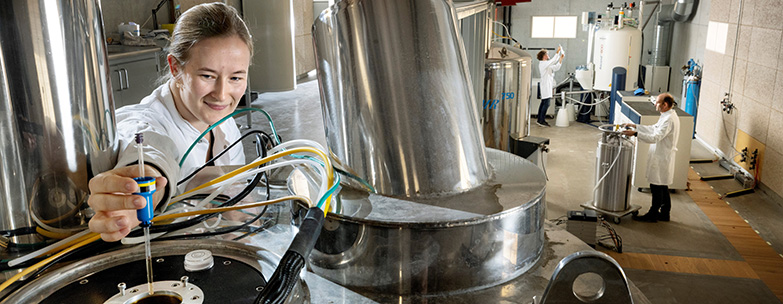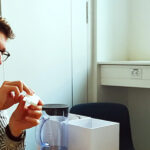High-end facility to solve industrial molecular mysteries
Atomic scale information can be useful for developers of innovative products. Especially products such as medicines or materials, that might end up in the body. There’s just one problem. Figuring out exact properties of novel organic molecules require devices, that are expensive and hard to use. A state-of-the-art NMR-facility in Copenhagen Science City now aims to provide detailed molecular information to developers in private industry. At low cost and with a minimum of fuss. By Jes Andersen.
NMR as-a-service
cOpenNMR is a University of Copenhagen initiative funded by the Novo Nordisk Foundation. Originally built for researchers at the university’s Department of Biology, it now aims to provide Nuclear Magnetic Resonance information to academics and companies throughout Denmark, explains the manager of the facility.
Our goal is to lower the bar to use NMR, and to convince more people, that NMR can answer the questions they might have… Or even help them to start asking the right questions”: Andreas Prestel, Manager, cOpenNMR facility.
Advice is free
Companies with an analysis problem are invited to a free-of-charge consultation with cOpenNMR to discuss whether NMR is the right technique for their problem and to get advice on sample preparation and experimental design. Only the actual measurement activities and data processing will cost them money, and not much at that, says Prestel.
We are funded by the Novo Nordisk Foundation to introduce NMR to industry and academia. Thanks to their generous donation, we do not need to turn a profit, and can provide these services at a fair cost:” Andreas Prestel, Manager, cOpenNMR facility.
Relevant for many types of company
NMR can analyse almost any kind of soluble organic compound. This includes polymers, pharmaceuticals, foods and much more. The team operating the NMR-facility are specialists in proteins and their interactions with membranes in beings from bacteria over plants to animals. They hope to see users from many domains but expect their first commercial customers to come from life science and biotech. The life science incubator and accelerator programme, BioInnovation Institute certainly expects start-up companies in their portfolio to become users.
Advanced technologies such as NMR are routinely used in larger life science companies, but they are usually not easily available to start-ups like the ones participating in BII’s programs. The cOpenNMR facility makes it possible for smaller companies to access cutting edge NMR instruments and the expertise needed to use them to support drug development and other applications.”
Markus Herrgård, CTO, BioInnovation Institute
Rich but frightening
Nuclear Magnetic Resonance provides information about which atoms are positioned where in a sample. This makes it useful for analysing purity, stability and structure of molecules, but also quantity, interaction and even behaviour over time: from nanoseconds to years. For some users though, this very wealth of information is also what makes the technique seem scary.
Much better than its reputation.
Andreas Prestel really likes NMR, and thinks it is one of the best methods around, so he hopes to de-mystify it.
Some have heard that you need a lot of sample material because the technology is not very sensitive. Others believe that it is almost impossible to make sense of the amount of data you get out of a measurement. Both beliefs are inaccurate. The present generation of machines are highly sensitive, and we have become very good indeed at designing experiments to extract exactly the information you need”: Andreas Prestel, Manager, cOpenNMR facility.
Highway from contact to contract
In principle, the cOpenNMR facility has been open to industry since its inception in 2020. In practice it has been difficult for companies to figure out how to approach it. This has been remedied with an upgraded homepage, an easy-to-use registration process and even a standardized contract outlining terms of use and intellectual property issues.
Heavy machinery
All NMR instruments at the facility are new or almost new. cOpenNMR features a 600 MegaHertz (MHz), a 750 MHz and the only 800 MHz spectrometer on Danish soil able to detect carbon and nitrogen directly. These are all relatively powerful machines with very good signal-to-noise ratios. The team hopes to raise funds for a 1,200 MHz machine in the near future, to cater to users who need to measure very large or very dynamic systems. The new capabilities of such a powerful instrument should expand the range of applications considerably.
Three models for use
Potential users may come with many different backgrounds and levels of skill. In order to cater to all, cOpenNMR has created three levels of services. A full service, where the company drops the sample off at the desk and gets annotated data analysis back. A minimal support model, where cOpenNMR prepares and analyses the sample, and sends raw data back to the company and a “DIY” model, where companies get full remote access to the spectrometers and take care of the rest themselves.
A magnet for research-intensive life science companies
cOpenNMR is just one of several state-of-the-art analysis-, trial- and test facilities in Copenhagen Science City. Others include the Proteomics Research Infrastructure and the University of Copenhagen Core Facility for Integrated Microscopy These facilities are important for the relevance of the innovation district for the companies the district works to attract, says Kristoffer Klebak of Copenhagen Science City.
We aim to build an innovation district which is the best place in Europe to launch or boost a research-based business. cOpenNMR makes our district more attractive to life science companies or their R&D-divisions”: Kristoffer Klebak, Head of Secretariat, Copenhagen Science City.




